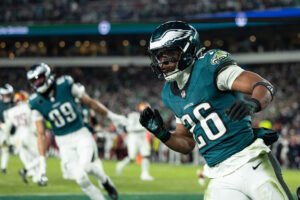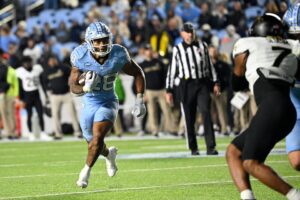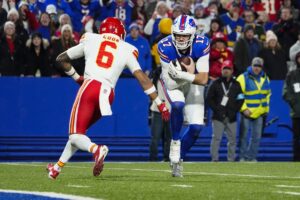This series will go position by position to look at the tiers of where NFL draft prospects stack up to each other. Rankings are great for discussion, but so many factors such as coaching, scheme fit and usage will affect who actually will have more NFL success. Every player in each tier could easily be the top player in the tier based on these factors. Any prospect not discussed unfortunately did not have enough adequate tape to have a full evaluation. For this edition, we look at wide receivers.
2017 NFL Draft: Wide Receiver Tiers
Tier 1
1. Corey Davis, Western Michigan
Davis is a 6’3” wide receiver, but his best traits come in the possession and finesse game. He wins with footwork, body control, and fluidity. He is able to create separation with and without the ball and has the most diverse route tree of the top playmakers. Davis has strong hands and can use his frame and length to add to the fact that he would make a great possession receiver. Davis has sat out the pre-draft process with an ankle injury and could work on being a more physical receiver with contested catches, but his size and fluidness to create give him the most upside.
2. Mike Williams, Clemson
Williams wins with the ball in the air. He is not a burner and does not always create separation. However, he has great ball tracking abilities and uses his physical traits and hands to make tough catches and pluck away contested catches from defenders. Williams is an accuracy eraser, red zone threat and uses most of his pros to eliminate the biggest cons from his game.
3. John Ross, Washington
It is obvious thanks to his 40 time, but Ross wins with speed. Aside from a record breaking 40, Ross is more than just a one-trick pony deep threat. He is even more dynamic with the ball in his hands and has strong enough footwork to create separation in short to intermediate passing. The downside with Ross is his physical frame. He has been banged up throughout his career, and currently has a shoulder ailment. His frame also affects his ability to make contested catches, and with some drop issues as well, he does have some flaws to monitor.
4. Ishmael Zamora, Baylor
Ishmael Zamora is the Joe Mixon of wide receivers. Zamora has a plethora of off-field issues, headlined by being charged with animal abuse before last season. However, on the field, Zamora should be a first round pick and has the highest ceiling of any wide receiver in the class. Zamora is a freak athlete and has great instincts in the air. He can contort his body, catches the ball away from his body, and is as good if not better than Mike Williams with the ball in the air.
Add in that he is faster and can jump higher than Williams, and the sky’s the limit. Zamora has a limited route tree and takes plays off, but so did Corey Coleman of Baylor who was the top wide receiver last year. Zamora has some consistency issues with his hands, but his ceiling is leaps and bounds higher than Coleman and it will be interesting to see who takes a shot on the enigmatic skill player.
Tier 2
5. Chris Godwin, Penn State
Godwin is another player who wins with the ball in the air. He is not the sharpest route runner, but if the ball is in his area, he is pulling it down. He highlighted that in his breakout performance in the Rose Bowl last season. Godwin is not the most well-refined route runner, but he is one of the best athletes in the class, and his ability to win with contested catches, and with the ball in his hands gives him an extremely high NFL ceiling.
6. JuJu Smith-Schuster, USC
Smith-Schuster comes in as the youngest wide receiver in the class. He also brings a unique skill set that makes his ceiling higher than others. Smith-Schuster is a physical receiver who is not afraid to block or seek out contact with the ball in his hands. He is skilled going over the middle and being a possession receiver. He may not take the top off and would be best in the NFL as a number two wide out. But his desire and age projection could turn him into a high volume fan favorite in the NFL.
Tier 3
7. Zay Jones, East Carolina
Jones has had one of the best pre-draft processes of any player in the entire draft. He shined at the Senior Bowl and owned the Combine. Jones was not great at creating separation, and most of his receptions were targets manufactured for him. His best bet in the NFL is a big slot option who can move around and find space in the short to intermediate game. However, the NFL is becoming a three-wide league, and Jones is easily the best slot option in the draft.
8. Curtis Samuel, Ohio State
Is Samuel a running back or wide receiver? He goes in with the skill set of a Tyreek Hill, Tavon Austin type of player, and will get the label “offensive weapon” in the NFL. He is blazing fast, shifty and can create on drags, reverses, and screens. He dances a bit too much, and it can result in losses of yards, but his big play peaks make the lows worth it.
9. Josh Reynolds, Texas A&M
Reynolds is a big time playmaker. He is thin and does not have great playing strength, but Reynolds shows great footwork to beat press coverage. From there he can take off down the field, and use his size, speed, and arm length to make outstanding catches. He had a limited route tree in college but has the footwork to show it can be refined. Reynolds also has some concentration drops, but he makes the tough ones, and it is enough to get excited about.
10. Ardarius Stewart, Alabama
You want to get the ball in the hands of Stewart. He suffered through poor quarterback play, and his role in the offense was limited because of this. However, he runs with finesse feet, and physical power to elude and run through defenders in the open field. Stewart is also a stud blocker coming from his run-heavy offense. Stewart is already 23, which limits how high his ceiling is and how well refined of a route runner he can be. However, he can make an impact next season and can be a versatile chess piece in any offense.
11. Carlos Henderson, Louisiana Tech
Henderson exploded onto the scene in 2016. He became a major big play threat, with solid speed and great leaping ability. He does not have a well-refined route tree, and the offense he was in set him up for success. However, the raw traits are there to provide a ceiling higher than where he currently is.
12. Taywan Taylor, Western Kentucky
Taylor can be a great possession or slot type of wide receiver in the NFL. He has outstanding foot speed and quickness in and out of his breaks to create separation. Taylor is a bit of a body catcher, and it can limit his contested catches and ability to make plays down the field. However, in an up-tempo, high volume offense, Taylor can feast on targets and create yards after the catch.
13. KD Cannon, Baylor
Cannon is a big play threat. He isn’t the biggest wide receiver, but he can use his speed to create separation and plays with a “my ball” mentality to be dynamic as a downfield, contested catch threat. Like Zamora, his route tree is limited, and he took plays off. However, that is the system at Baylor and it did not affect the stock of Corey Coleman. Both Cannon and Zamora have as high of ceilings as Coleman, so the question is where is the hype for these two playmakers?
Tier 4
14. Chad Hansen, California
Hansen is shifty and quick footed. He works well with the ball in his hands and has the feet to create separation quickly in the short to intermediate game. He is not the strongest wide receiver and can be bullied with the ball in the air. If he cannot get off of the ball quick with his feet, he can also struggle with press coverage. However, as a number two wide receiver in an offense, he can make plays after the catch.
15. Cooper Kupp, Eastern Washington
Kupp is a fun route runner to watch and has very quick feet. He also has great size for how shifty he can be. However, he has never played on the outside and his game will have to translate to a big slot wide receiver. As a slot receiver, he is not as athletic as Zay Jones or dynamic with the ball in his hands as Curtis Samuel. Add in that he is 23 and lacks strong playing strength and his ceiling is essentially the player he is now. He can contribute right away but is not a high upside bet.
Tier 5
16. Amara Darboh, Michigan
Darboh is a long possession receiver. He is a fluid mover, and his length gives him a great catch radius and accuracy erasing abilities. Unfortunately, he has yet to consistently show off that skill set and suffers from too many body catches, letting the ball come to him rather than go get it. Still, his greatest issues are fixable, and his upside is higher than his ranking.
17. Noah Brown, Ohio State
Brown may fall thanks to the similar issues that made Michael Thomas fall just a season ago. The offense he is in does not demand high targets, and his attributes as a blocker showed off more than a receiver. While he is a great blocker, he is nowhere near the route runner and fluid mover as Thomas. Brown is still young and raw, which does give him upside. However, he does not have deep speed, and if he wants to make it in the NFL will have to expand his route tree and work on his footwork.
18. Isaiah Ford, Virginia Tech
Ford is essentially the opposite of Darboh. He plays bigger than his size, and his ability to catch the ball away from his body make him a solid deep threat. However, his route running and fluidity are lacking and he is limited to an outside threat and splash player. He does not possess the speed as some other outside threat in this class either.
Tier 5
19. Malachi Dupre, LSU
Dupre is a long strider and a great leaper who can create big splash plays. However, he suffers from drops and inconsistencies that limit his upside and make him a boom-bust prospect.
20. Dede Westbrook, Oklahoma
This is a boom or bust tier, and Westbrook is the perfect example. He is extremely fluid in movement and plays bigger than his size. However, his size is about 170 pounds which is tiny by NFL standards, and with a list off-field issues, including some medical questions he has a very low floor.
21. Jalen Robinette, Air Force
Robinette is another big play threat with size, speed, and a great catch radius. However, he hails from a run heavy offense and showed inconsistencies with concentration drops as a result of it. His upside is what we wanted Stephen Hill to be, his downside is Stephen Hill.
22. Shelton Gibson, West Virginia
Gibson is a speed demon and a deep threat on the outside. However, he does not have an expanded route tree, and his upside is a one trick pony that can demand safety respect. The most realistic option for Gibson is a deadly return man who can give limited offensive snaps.
Tier 6
23. Ryan Switzer, North Carolina
Switzer’s size limits him to slot duties. However, he is great after the catch, and in the short passing game can find separation in space. There isn’t much ceiling to Switzer, but at the same time, he can play in the NFL right away.
24. Trent Taylor, Western Kentucky
Taylor has a fairly identical athletic profile to Switzer. Both will have the same role, and it will come down to which player has the better quarterback and offensive situation to see who has the better NFL career.
Tier 7
25. Kenny Golladay, Northern Illinois
This is the height weight speed project tier, and Golladay fits right in. He has a limited route tree, and likely will be used strictly as a splash player. He can be a bottom of the roster project but will have to prove himself on special teams to get real consideration.
26. Mack Hollins, North Carolina
Hollins is extremely intriguing from a height, weight, speed standpoint. However, he is a raw route runner with below average ball tracking skills. His best fit in the NFL could be as a fringe roster special team player.
27. Amba Etta-Towu, Syracuse
Etta-Towu looks great as a prospect until he has to actually catch the football. He has an issue with drops and it showed at the NFL Combine. If he can work on that he has some upside to start on the outside.
28. Robert Davis, Georgia State
Davis is another height, weight, speed project. He blew up against lower level competition, but he hardly has a route tree and relied on being the best athlete on the field, rather than winning with technical aspects.
29. Deangelo Yancey, Purdue
Yancey has great size and was a playmaker down the field throughout his college career. He can be slow out of his breaks and needs quicker feet, but he has a chance to be a splash player in the NFL.
Tier 8
30. Jehu Chesson, Michigan
Chesson has great size, but a knee injury in 2015 seemed to have taken a level of speed away from him. He struggled to get separation last season, and being a bit of a body catcher, his catch radius is pretty small. If he can get back to his 2015 athleticism, he has upside, if not he is going to have to hang around with special teams.
31. Stacy Cooley, Miami
Cooley is a speed threat and splash player, but lacks quick breaks and playing strength to shed press coverage. His upside is likely a Jeremy Kerley type of player, but he can provide help on special teams.
32. Chad Williams, Grambling
Chad Williams could be a sleeper as a small school prospect who dominated his competition. He did have a big game against Arizona but likely excelled so much due to being heavily targeted. He has a limited route tree and is a developmental, low-end roster bet.
Tier 9
33. Speedy Noil, Texas A&M
Noil is a freak athlete and former top prospect. However, he has a plethora of off-field issues, and his desire may not be there. It shows in his routes, and while he is dynamic with the ball in his hands, he will have to be manufactured touches to show that.
34. Fred Ross, Mississippi State
Ross tore up the SEC with Dak Prescott and fell off hard without him. He doesn’t have great size but is a fluid mover who can find space in the short to intermediate game. Still, without agility he is a possession slot receiver at best, and likely will have to earn a roster spot playing special teams.
35. Damore’ea Stringfellow, Ole Miss
Stringfellow is a fluid mover and has a wide catch radius. Still, he is slow off of the ball and is not quick enough in his breaks to create NFL separation.
36. Travin Dural, LSU
Dural was once a great prospect, but his college career saw knee, hamstring and shoulder injuries. It took a toll on his play and showed at the combine as he is nowhere near the athlete he once was projected to be.
37. Josh Malone, Tennessee
Malone has great size at 6’3”, and plays to it but is slow in his breaks, and is likely a red zone option at best in the NFL.
Tier 10
38.Travis Rudolph, Florida State
Rudolph could be looked at as a potential slot, possession option. However, he tested extremely poorly at the Combine, and likely does not have the foot quickness to win in space or create separation.
39. Artavis Scott, Clemson
Artavis Scott is a gadget player with little agility or playing strength. His best bet to make a roster is as a fifth wide receiver who can be used in the return game.
Main Photo:






